Evaluation of Satellite Precipitation Products with Rain Gauge Data at Different Scales: Implications for Hydrological Applications
Abstract
:1. Introduction
2. Materials and Methods
2.1. Study Area
2.2. Data Acquisition and Processing
2.3. Metrics for Accuracy Assessment
3. Results
3.1. Comparison for Grid Boxes with or without GPCC Reporting Gauges
3.2. Inter-Comparison between Satellite Produncts and Rain Gauge Data
3.3. TRMM Accuracy for Different Rain Rates
3.4. Seasonal Pattern of TRMM Accuracy
3.5. Spatial Characteristics of TRMM Product Performance
4. Discussion
5. Conclusions
Acknowledgments
Author Contributions
Conflicts of Interest
Abbreviations
| TMPA | TRMM multi-satellite precipitation analysis |
| TMI | TRMM microwave imager |
| PR | precipitation radar |
| RMSE | root mean square error |
| GCTE | global change and terrestrial ecosystems |
| IGBP | project of the International Geosphere–Biosphere Programme |
| CAMS | Climate Assessment and Monitoring System |
| GPCC | Global Precipitation Climatology Centre |
| CMA | Center of the China Meteorological Administration |
| ME | mean error |
| E | error |
| RE | relative error |
| RMSE | root mean square error |
| MAE | mean absolute error |
| NRMSE | normalized root mean squared error |
| NMAE | normalized mean absolute error |
References
- Barrett, E.C.; Beaumont, M.J. Satellite rainfall monitoring for agrometeorology: Operational problems, practices and prospects. EARSeL Adv. Remote Sens. 1993, 2, 66–72. [Google Scholar]
- Barrett, E.C.; Beaumont, M.J. Satellite rainfall monitoring: An overview. Remote Sens. Rev. 1994, 11, 23–48. [Google Scholar] [CrossRef]
- Krajewski, W.F. Ground Networks: Are We Doing the Right Thing? In Measuring Precipitation from Space; Springer: Dordrecht, The Netherlands, 2007; pp. 403–417. [Google Scholar]
- Kidd, C. Satellite rainfall climatology: A review. Int. J. Climatol. 2001, 21, 1041–1066. [Google Scholar] [CrossRef]
- Durkee, J. Precipitation measurement and the advancement toward global observations. Geogr. Compass 2010, 4, 956–978. [Google Scholar] [CrossRef]
- Michaelides, S.C. Precipitation: Advances in Measurement, Estimation and Prediction; Springer: Heidelberg, Germany, 2008. [Google Scholar]
- Kidd, C.; Levizzani, V.; Bauer, P. A review of satellite meteorology and climatology at the start of the twenty-first century. Progr. Phys. Geogr. 2009, 33, 474–489. [Google Scholar] [CrossRef]
- Kidd, C.; Levizzani, V. Status of satellite precipitation retrievals. Hydrol. Earth Syst. Sci. 2011, 15, 1109–1116. [Google Scholar] [CrossRef]
- Wilheit, T.; Adler, R.; Avery, S.; Barrett, E.; Bauer, P.; Berg, W.; Chang, A.; Ferriday, J.; Grody, N.; Goodman, S.; et al. Algorithms for the retrieval of rainfall from passive microwave measurements. Remote Sens. Rev. 1994, 11, 163–194. [Google Scholar] [CrossRef]
- Iguchi, T.; Kozu, T.; Meneghini, R.; Awaka, J.; Okamoto, K. Rain-profiling algorithm for the TRMM precipitation radar. J. Appl. Meteorol. 2000, 39, 2038–2052. [Google Scholar] [CrossRef]
- Levizzani, V.; Amorati, R.; Meneguzzo, F.; Amorati, R.; Meneguzzo, F. A review of satellite-based rainfall estimation methods. In European Commission Project MUSIC Report (EVK1-CT-2000-00058); Istituto di Biometeorologia-CNR: Bologna, Italy, 2002; p. 66. [Google Scholar]
- Kummerow, C.; Barnes, W.; Kozu, T.; Shiue, J.; Simpson, J. The tropical rainfall measuring mission (TRMM) sensor package. J. Atmos. Ocean Technol. 1998, 15, 809–817. [Google Scholar] [CrossRef]
- Joyce, R.J.; Janowiak, J.E.; Arkin, P.A.; Xie, P. CMORPH: A method that produces global precipitation estimates from passive microwave and infrared data at high spatial and temporal resolution. J. Hydrometeorol. 2004, 5, 487–503. [Google Scholar] [CrossRef]
- Turk, F.J.; Miller, S.D. Toward improved characterization of remotely sensed precipitation regimes with MODIS/AMSR-E blended data techniques. IEEE Trans. Geosci. Remote Sens. 2005, 43, 1059–1069. [Google Scholar] [CrossRef]
- Ushio, T.; Sasashige, K.; Kubota, T.; Shige, S.; Okamoto, K.; Aonashi, K.; Inoue, T.; Takahashi, N.; Iguchi, T.; Kachi, M.; et al. A Kalman filter approach to the Global Satellite Mapping of Precipitation (GSMaP) from combined passive microwave and infrared radiometric data. J. Meteorol. Soc. Jpn. 2009, 87, 137–151. [Google Scholar] [CrossRef]
- Huffman, G.J.; Adler, R.F.; Bolvin, D.T.; Gu, G.; Nelkin, E.J.; Bowman, K.P.; Hong, Y.; Stocker, E.F.; Wolff, D.B. The TRMM multisatellite precipitation analysis (TMPA): Quasi-global, multiyear, combined-sensor precipitation estimates at fine scales. J. Hydrometeorol. 2007, 8, 38–55. [Google Scholar] [CrossRef]
- Minobe, S.; Miyashita, M.; Kuwano-Yoshida, A.; Tokinaga, H.; Xie, S.P. Atmospheric response to the gulf stream: Seasonal variations*. J. Clim. 2010, 23, 3699–3719. [Google Scholar] [CrossRef]
- Ji, X.; Chen, Y. Characterizing spatial patterns of precipitation based on corrected TRMM 3B43 data over the mid Tianshan Mountains of China. J. Mt. Sci. 2012, 9, 628–645. [Google Scholar] [CrossRef]
- Naumann, G.; Barbosa, P.; Carrao, H.; Singleton, A.; Vogt, J. Monitoring drought conditions and their uncertainties in Africa using TRMM data. J. Appl. Meteorol. Clim. 2012, 51, 1867–1874. [Google Scholar] [CrossRef]
- As-syakur, A.R.; Tanaka, T.; Osawa, T.; Mahendra, M.S. Indonesian rainfall variability observation using TRMM multi-satellite data. Int. J. Remote Sens. 2013, 34, 7723–7738. [Google Scholar] [CrossRef]
- Rahman, S.H.; Debasis, S.; Ravichran, M. Variability of Indian summer monsoon rainfall in daily data from gauge and satellite. J. Geophys. Res. Atmos. 2009, 114, 767–773. [Google Scholar] [CrossRef]
- Dinku, T.; Ceccato, P.; Grover-Kopec, E.; Lemma, M.; Connor, S.J.; Ropelewski, C.F. Validation of satellite rainfall products over East Africa's complex topography. Int. J. Remote Sens. 2007, 28, 1503–1526. [Google Scholar] [CrossRef]
- Fleming, K.; Awange, J.L.; Kuhn, M.; Featherstone, W.E. Evaluating the TRMM 3B43 monthly precipitation product using gridded raingauge data over Australia. Aust. Meteorol. Oceangr. J. 2011, 61, 171–184. [Google Scholar]
- Chokngamwong, R.; Chiu, L.S. Thailand Daily Rainfall and Comparison with TRMM Products. J. Hydrometeorol. 2008, 9, 256–266. [Google Scholar] [CrossRef]
- As-Syakur, A.R.; Tanaka, T.; Prasetia, R.; Swardika, I.K.; Kasa, I.W. Comparison of TRMM multisatellite precipitation analysis (TMPA) products and daily-monthly gauge data over Bali. Int. J. Remote Sens. 2011, 32, 8969–8982. [Google Scholar] [CrossRef]
- Semire, F.A.; Mohd-Mokhtar, R.; Ismail, W.; Mohamad, N.; Mandeep, J.S. Ground validation of space-borne satellite rainfall products in Malaysia. Adv. Space Res. 2012, 50, 1241–1249. [Google Scholar] [CrossRef]
- Karaseva, M.O.; Prakash, S.; Gairola, R.M. Validation of high-resolution TRMM-3B43 precipitation product using rain gauge measurements over Kyrgyzstan. Theor. Appl. Climatol. 2012, 108, 147–157. [Google Scholar] [CrossRef]
- Feidas, H. Validation of satellite rainfall products over Greece. Theor. Appl. Climatol. 2010, 99, 193–216. [Google Scholar] [CrossRef]
- Prakash, S.; Mahesh, C.; Gairola, R.M. Comparison of TRMM Multi-satellite Precipitation Analysis (TMPA)-3B43 version 6 and 7 products with rain gauge data from ocean buoys. Remote Sens. Rev. 2013, 4, 677–685. [Google Scholar] [CrossRef]
- Nair, S.; Srinivasan, G.; Nemani, R. Evaluation of Multi-Satellite TRMM Derived Rainfall Estimates over a Western State of India. J. Meteorol. Soc. Jpn. 2009, 87, 927–939. [Google Scholar] [CrossRef]
- Yashon, O.O.; Owiti, T.; Kipkorir, E.; Kibiiy, J.; Tateishi, R. Multitemporal comparative analysis of TRMM-3B42 satellite-estimated rainfall with surface gauge data at basin scales: Daily, decadal and monthly evaluations. Int. J. Remote Sens. 2012, 33, 7662–7684. [Google Scholar]
- Zhang, Q.; Liu, Y.; Yang, G.; Zhang, Z. Precipitation and hydrological variations and related associations with large-scale circulation in the Poyang Lake basin, China. Hydrol. Process. 2011, 25, 740–751. [Google Scholar] [CrossRef]
- Liu, Y.; Wu, G.; Zhao, X. Recent declines in China’s largest freshwater lake: Trend or regime shift? Environ. Res. Lett. 2013, 8, 014010. [Google Scholar] [CrossRef]
- Canadell, J.G.; Steffen, W.L.; White, P.S. IGBP/GCTE terrestrial transects: Dynamics of terrestrial ecosystems under environmental change. J. Veg. Sci. 2002, 13, 298–300. [Google Scholar] [CrossRef]
- Finlayson, M.; Harris, J.; McCartney, M.; Young, L.; Chen, Z. Report on Ramsar Visit to Poyang Lake Ramsar Site, P.R. China. Report Prepared on Behalf of the Secretariat of the Ramsar Convention. 12–17 April 2010. Available online: http://www.ramsar.org/pdf/Poyang_lake_report_v8.pdf (accessed on 13–14 April 2010).
- Chiu, L.S.; Liu, Z.; Vongsaard, J.; Morain, S.; Budge, A.; Neville, P.; Bales, C. Comparison of TRMM and water district rain rates over New Mexico. Adv. Atmos. Sci. 2006, 23, 1–13. [Google Scholar] [CrossRef]
- China Meteorological Administration. Ground Meteorological Observation Standard; Meteorological Press: Beijing, China, 2003. [Google Scholar]
- National Meteorological Center of China Meteorological Administration. Complilation of 30-Year Conventional Climate Data and Their Statistics; Standards Press of China: Beijing, China, 2004. [Google Scholar]
- Gires, A.; Tchiguirinskaia, I.; Schertzer, D.; Schellart, A.; Berne, A.; Lovejoy, S. Influence of small scale rainfall variability on standard comparison tools between radar and rain gauge data. Atmos. Res. 2014, 138, 125–138. [Google Scholar] [CrossRef]
- Jaffrain, J.; Berne, A. Influence of the Subgrid Variability of the Raindrop Size Distribution on Radar Rainfall Estimators. J. Appl. Meteorol. Climatol. 2012, 51, 780–785. [Google Scholar] [CrossRef]
- Ebert, E.E.; Manton, M.J.; Arkin, P.A.; Allam, R.J.; Holpin, G.E.; Gruber, A. Results from the GPCP algorithm intercomparison programme. Bull. Am. Meteorol. Soc. 1996, 77, 2875–2887. [Google Scholar] [CrossRef]
- Behrangi, A.; Khakbaz, B.; Jaw, T.C.; AghaKouchak, A.; Hsu, K.; Sorooshian, S. Hydrologic evaluation of satellite precipitation products over a mid-size basin. J. Hydrol. 2011, 397, 225–237. [Google Scholar] [CrossRef]
- Romilly, T.G.; Gebremichael, M. Evaluation of satellite rainfall estimates over Ethiopian river basins. Hydrol. Earth Syst. Sci. 2011, 15, 1505–1514. [Google Scholar] [CrossRef]
- Gao, Y.C.; Liu, M.F. Evaluation of high-resolution satellite precipitation products using rain gauge observations over the Tibetan Plateau. Hydrol. Earth Syst. Sci. 2013, 17, 837–849. [Google Scholar] [CrossRef]
- Prakash, S.; Sathiyamoorthy, V.; Mahesh, C.; Gairola, R.M. An evaluation of high-resolution multisatellite rainfall products over the Indian monsoon region. Int. J. Remote Sens. 2014, 35, 3018–3035. [Google Scholar] [CrossRef]
- Ebert, E.E. Methods for verifying satellite precipitation estimates. In Measuring Precipitation from Space; Springer: Dordrecht, The Netherlands, 2007; pp. 345–356. [Google Scholar]
- Villarini, G.; Mandapaka, P.V.; Krajewski, W.F.; Moore, R.J. Rainfall and sampling uncertainties: A rain gauge perspective. J. Geophys. Res. 2008, 113, 3078. [Google Scholar] [CrossRef]
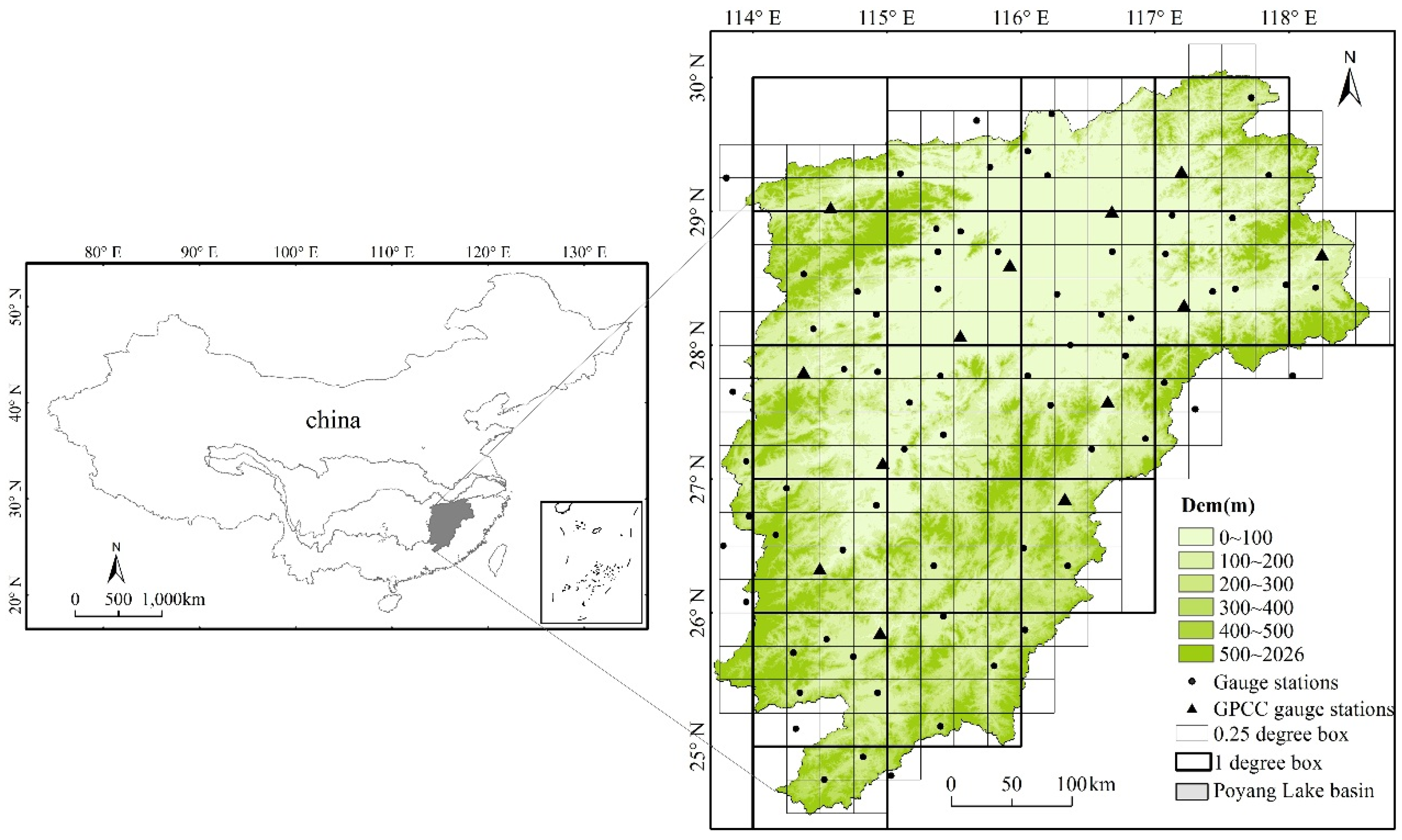
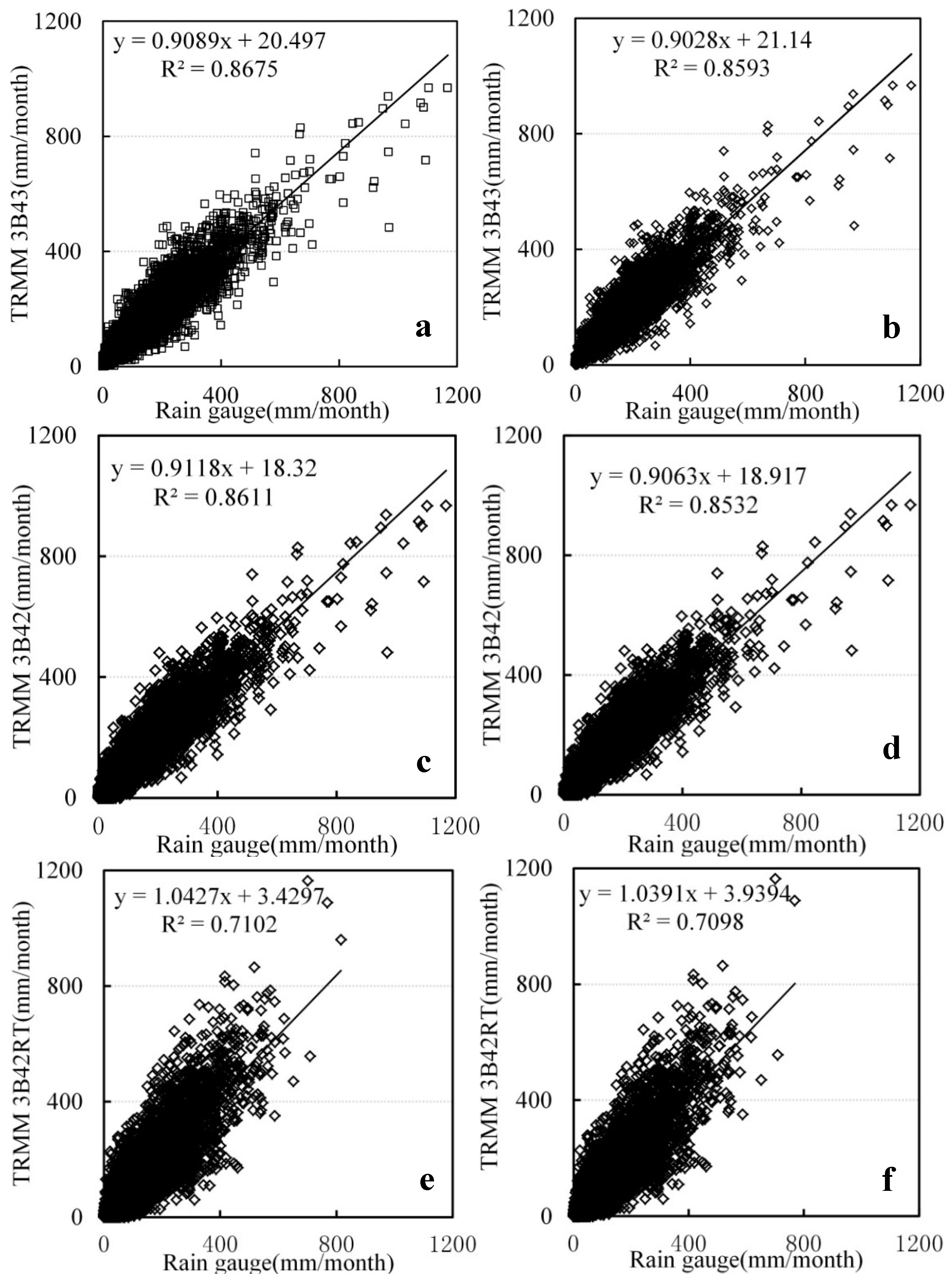
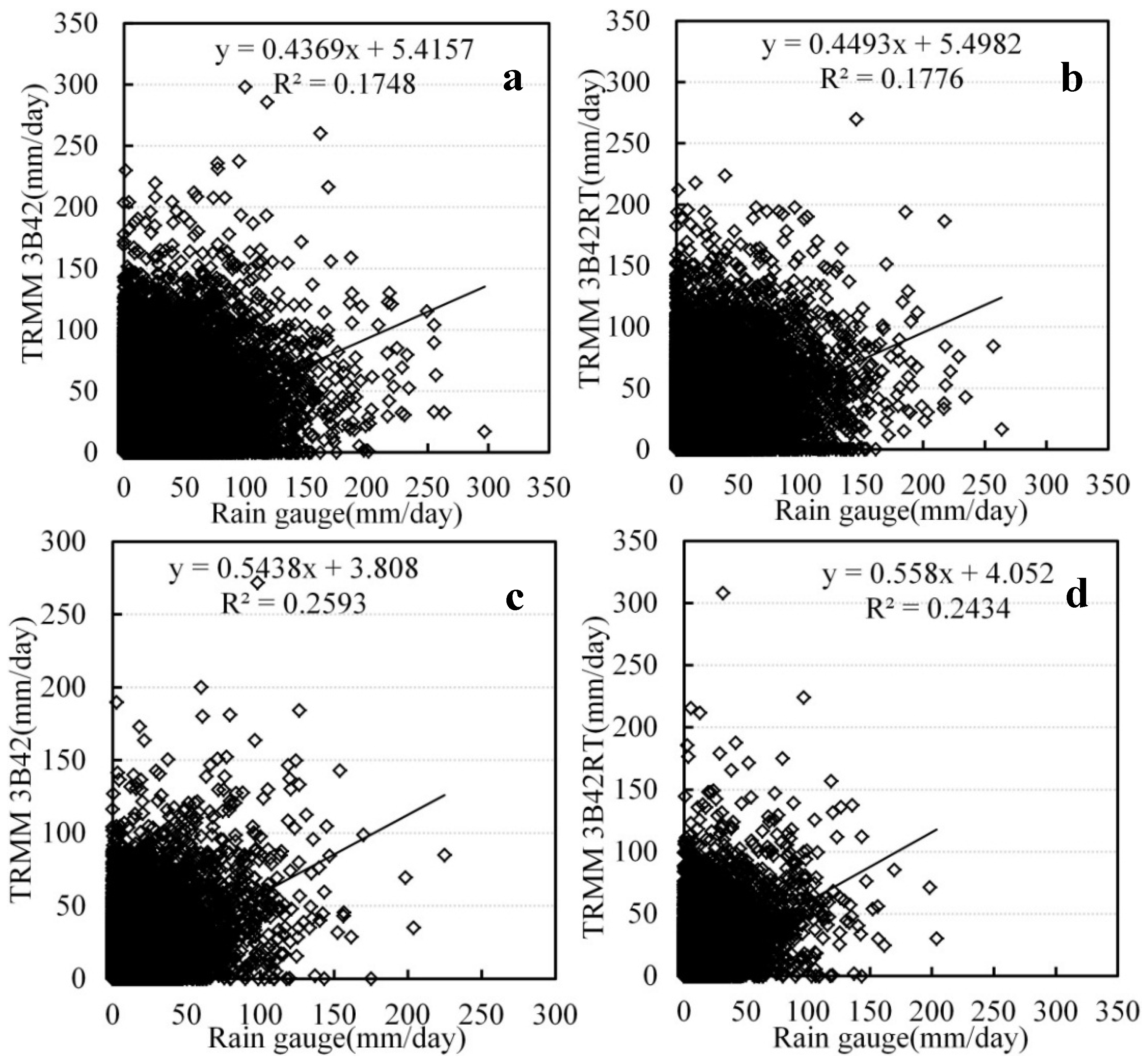
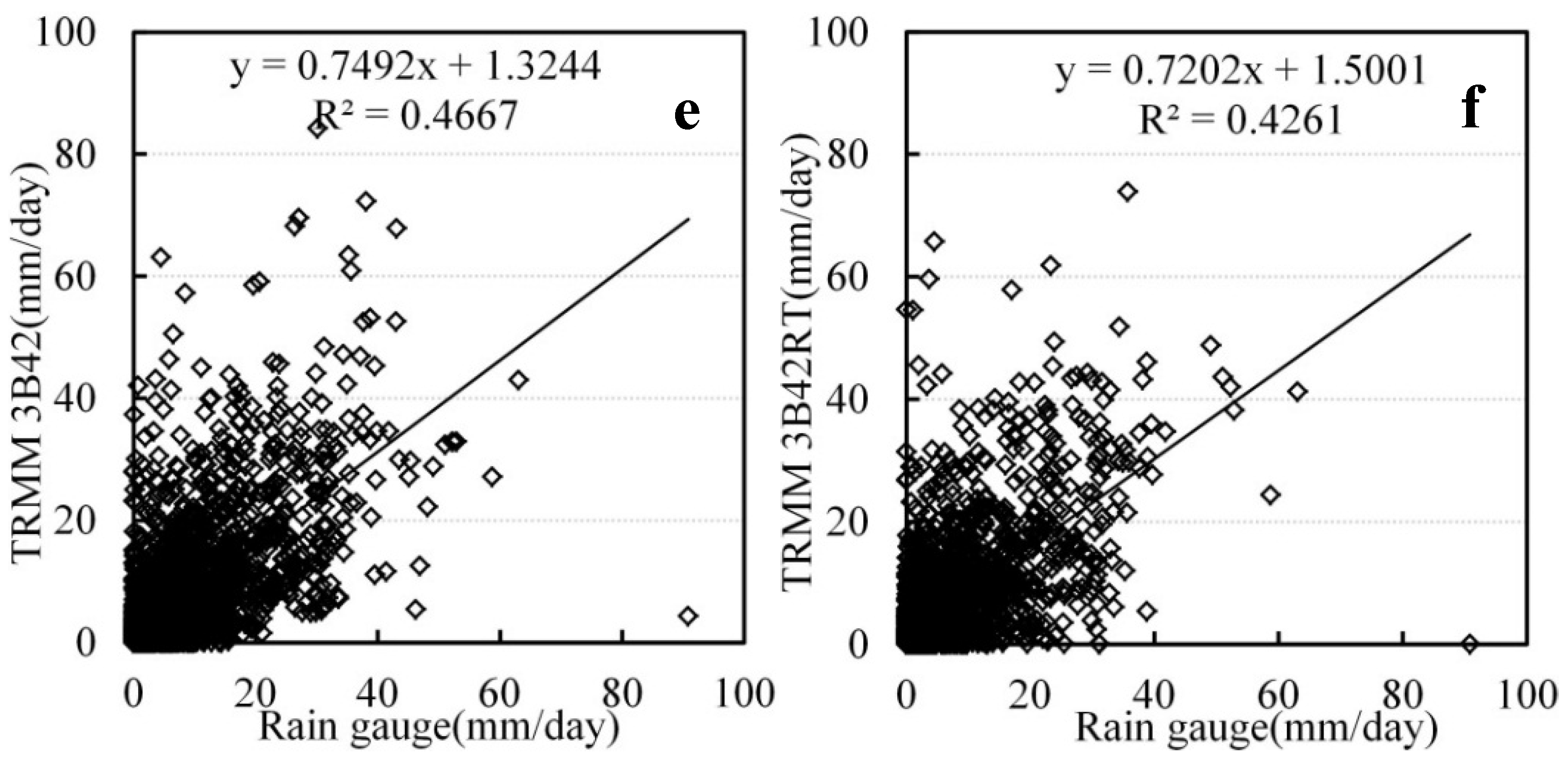
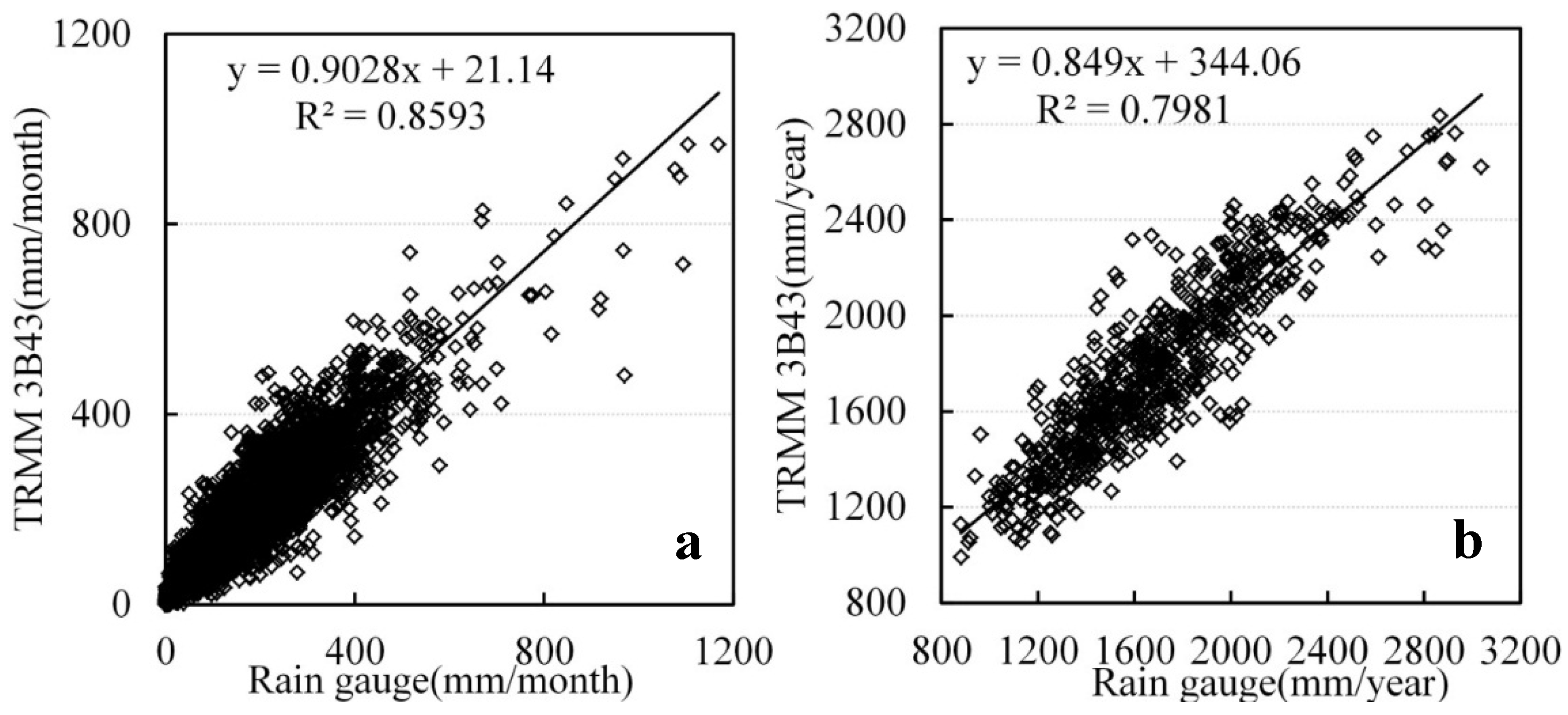
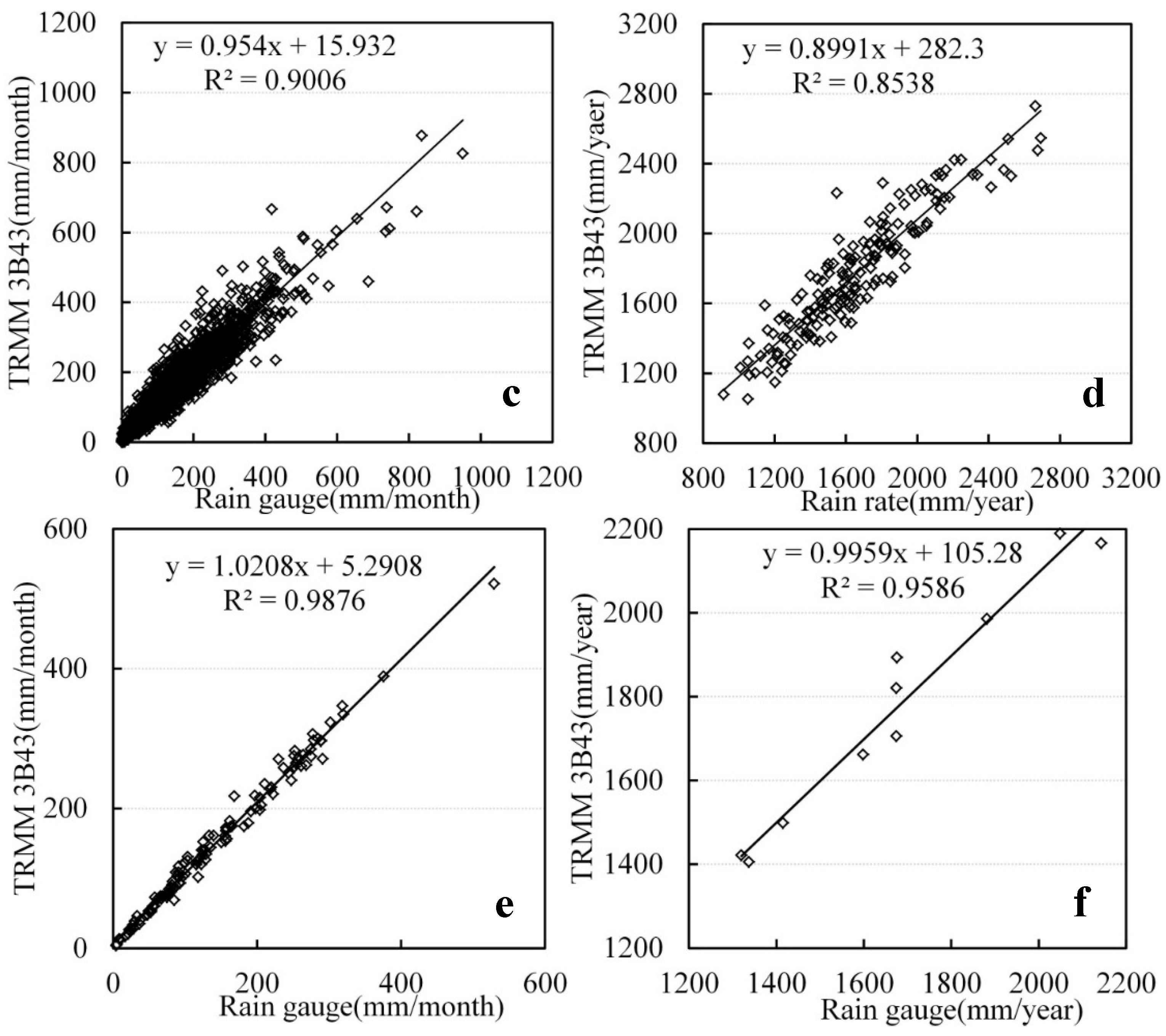



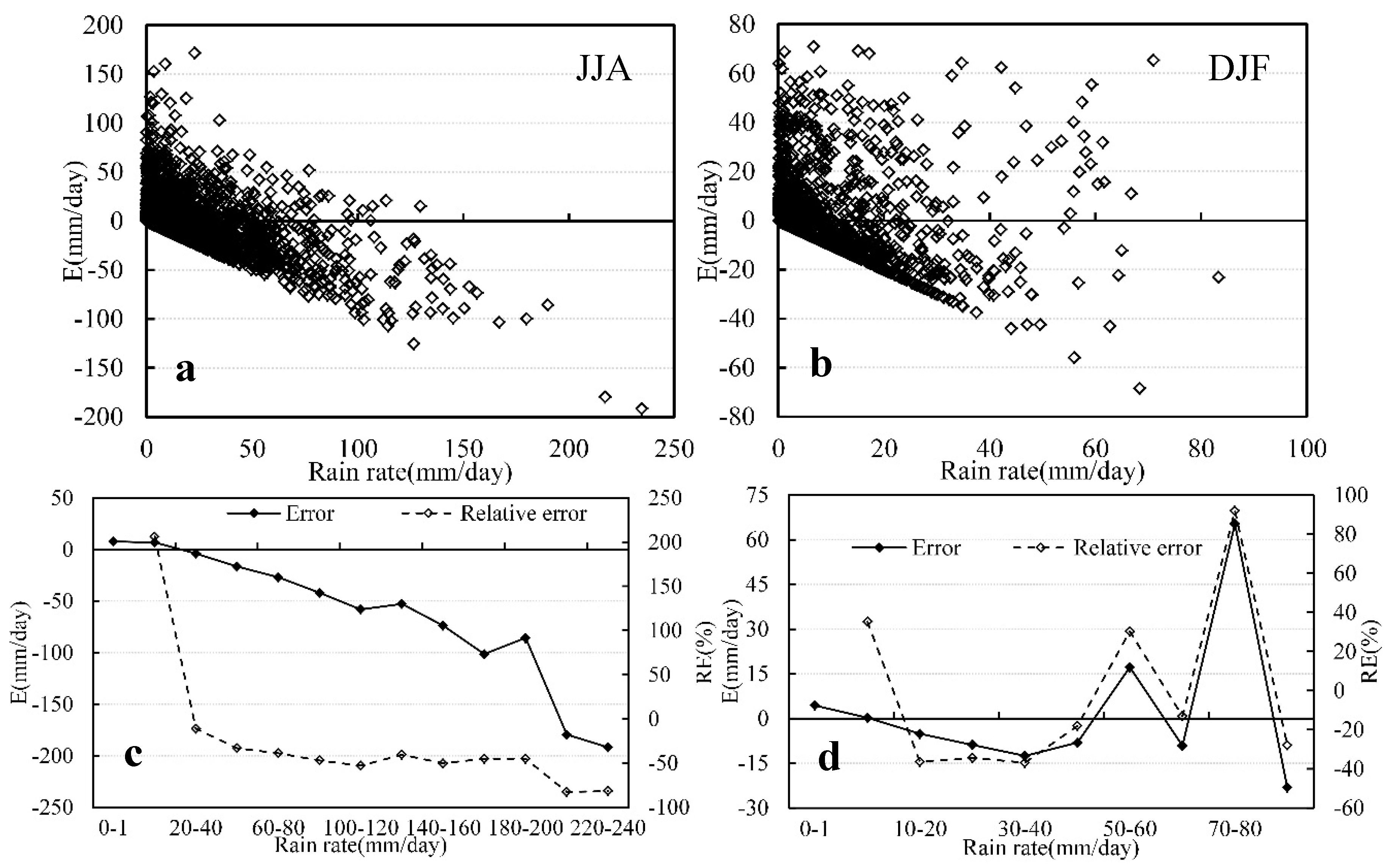
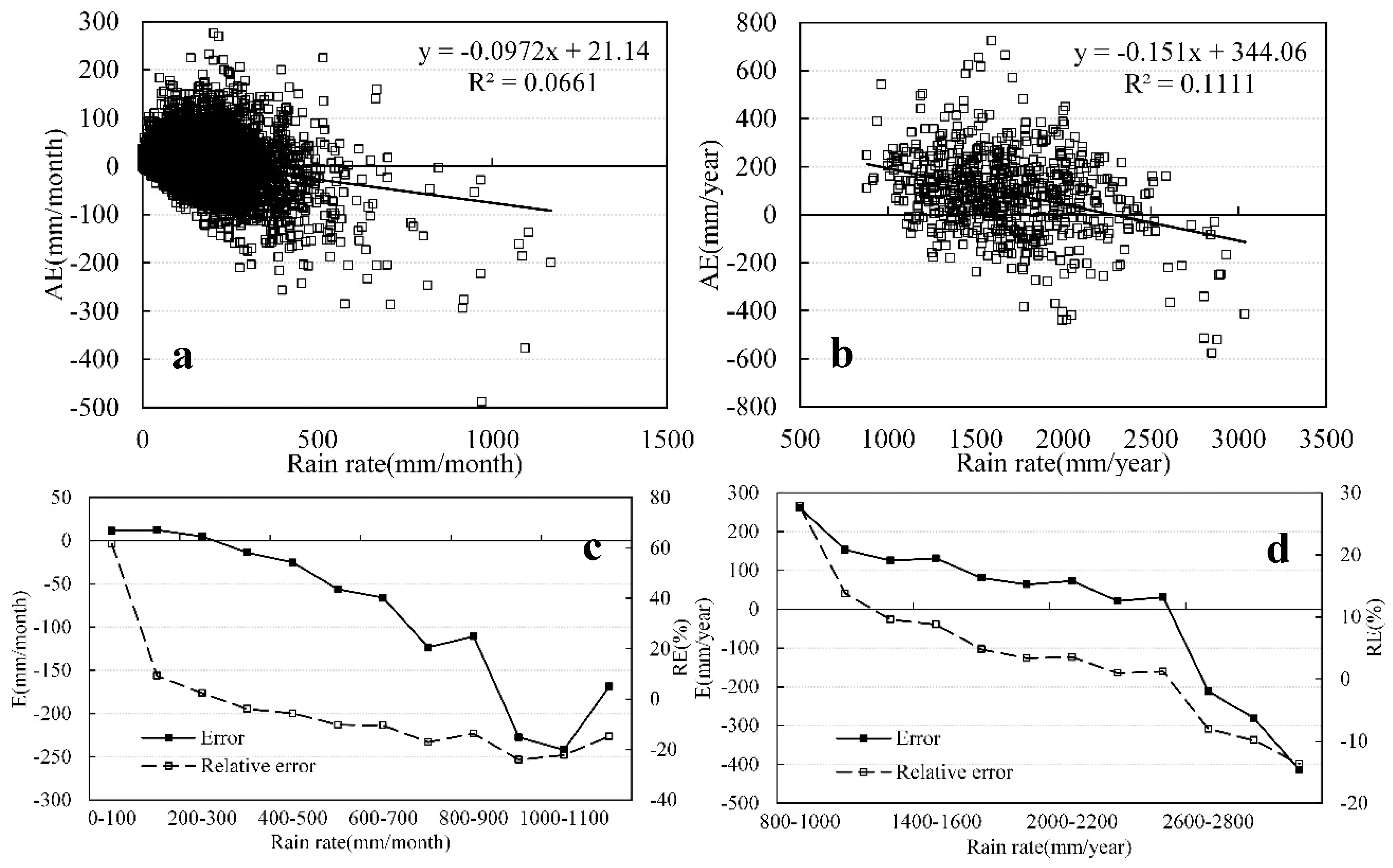
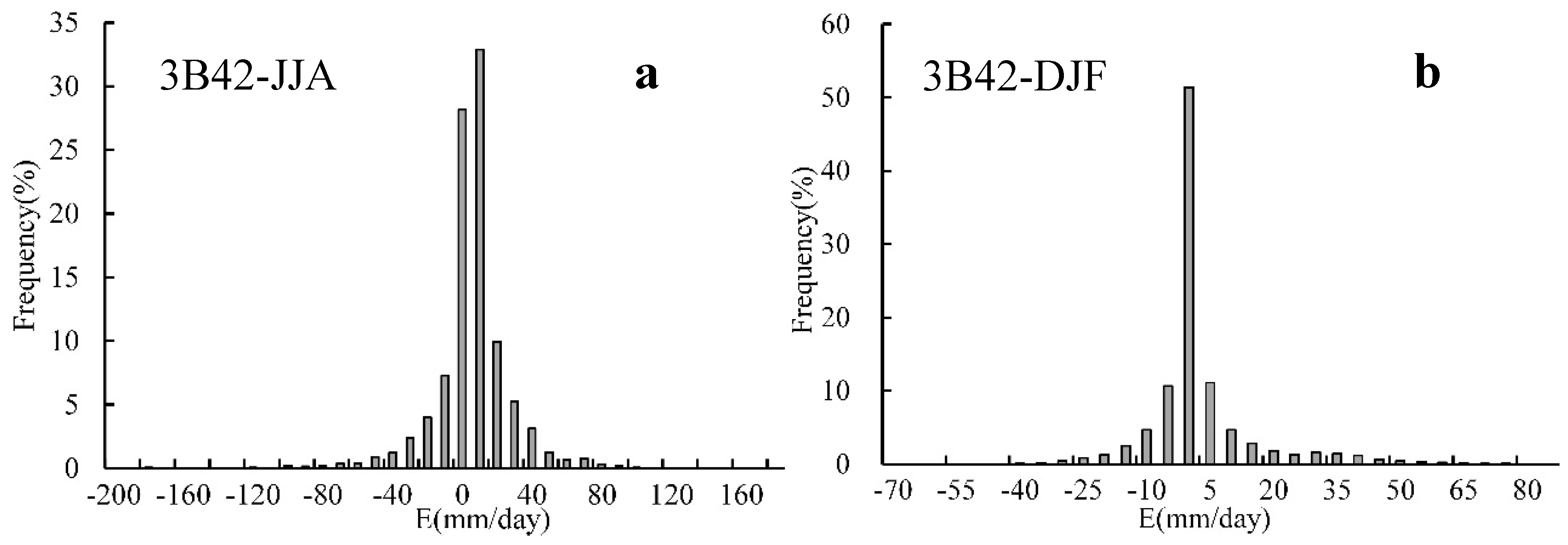
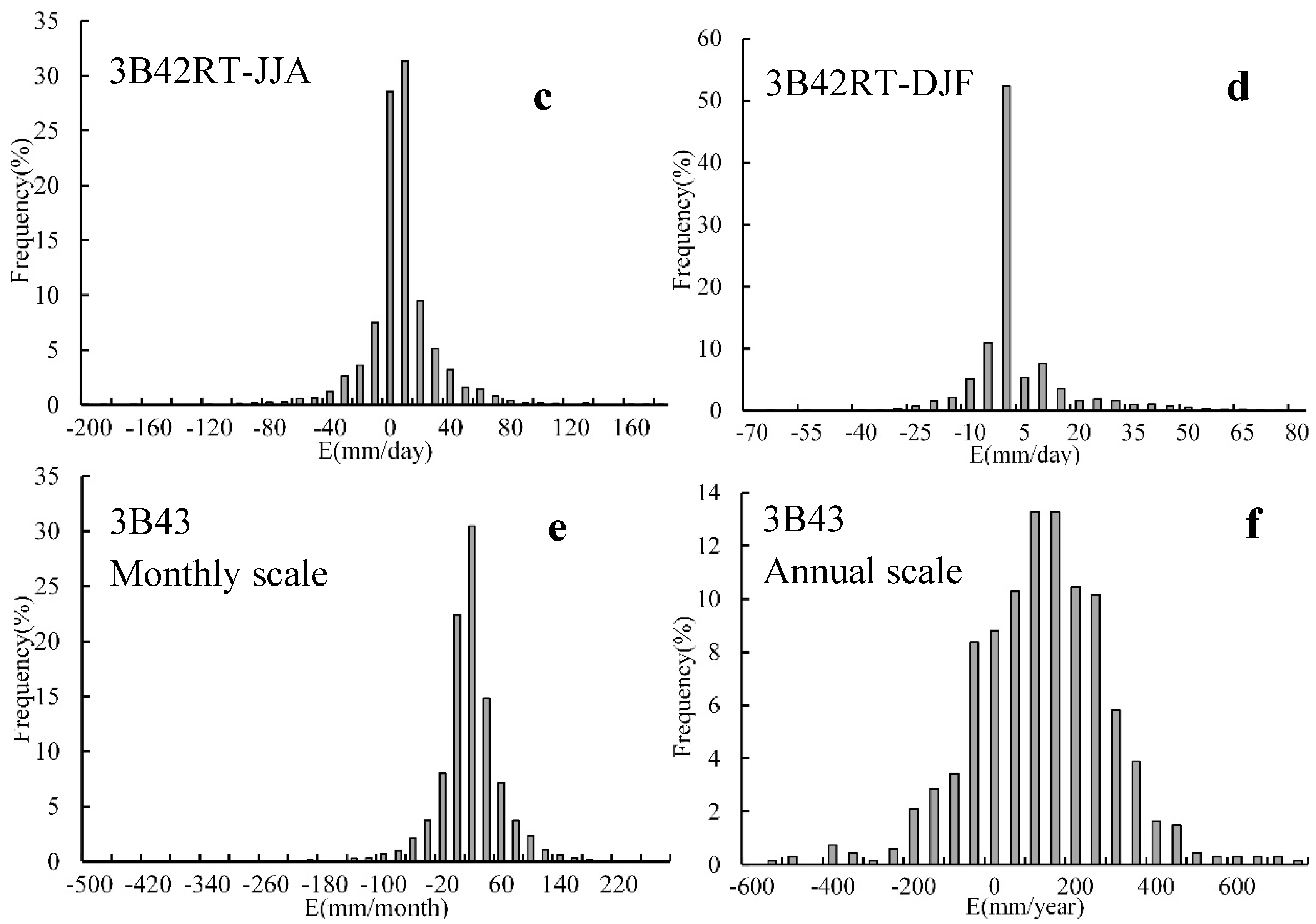
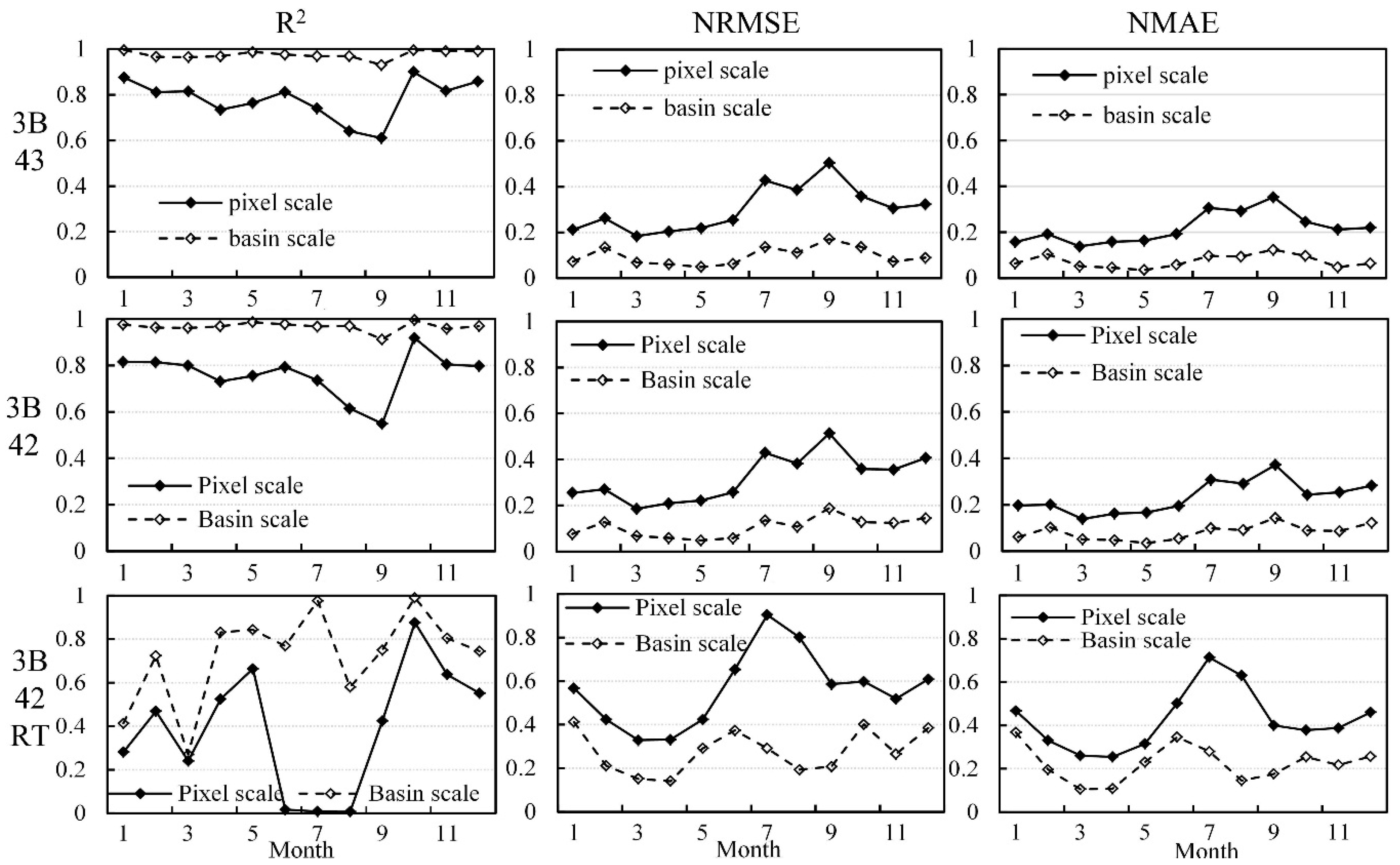
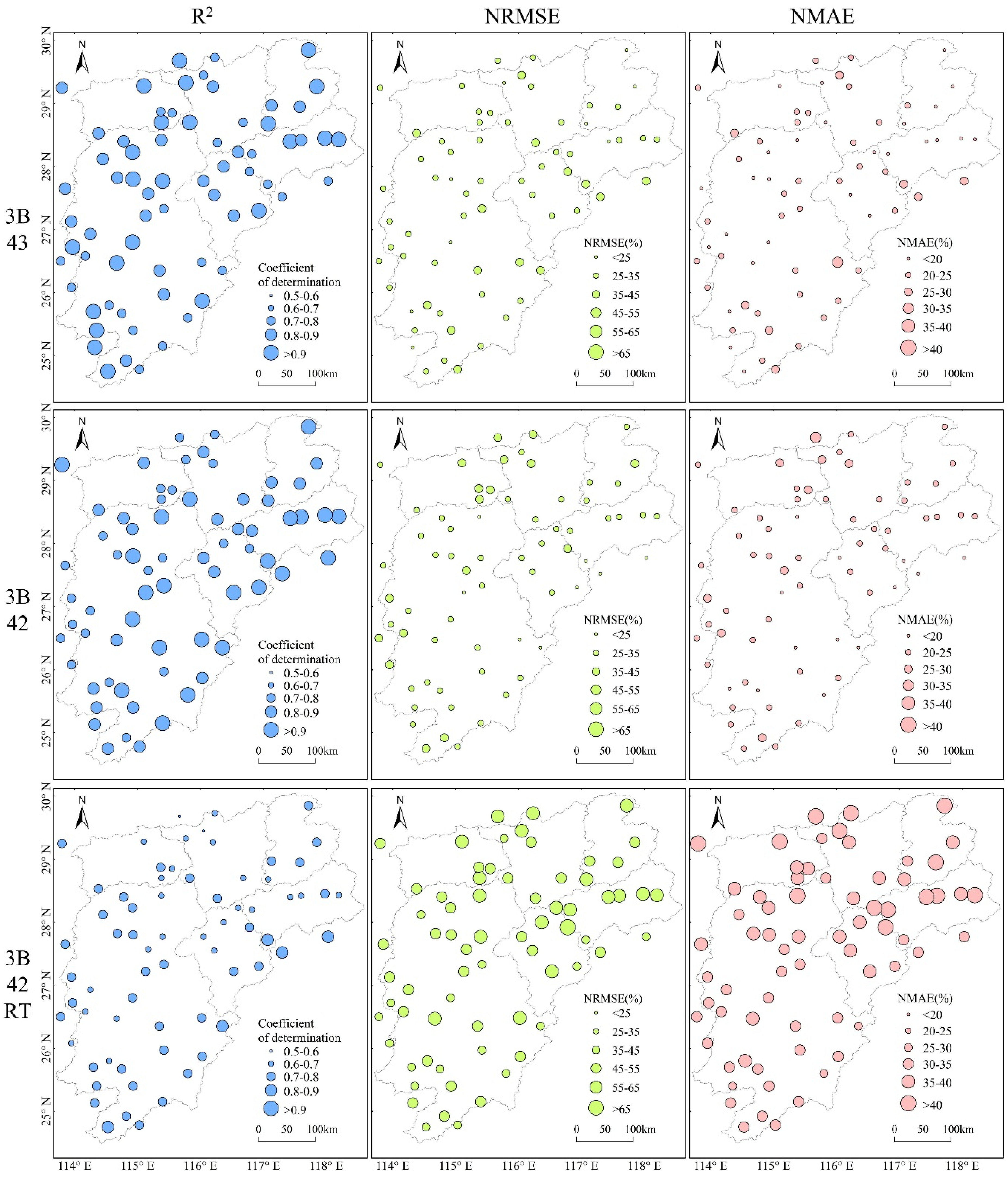

| Products | TRMM 3B43 | TRMM 3B42 | TRMM 3B42RT | ||||||
|---|---|---|---|---|---|---|---|---|---|
| – | 0.25° | 1° | Basin | 0.25° | 1° | Basin | 0.25° | 1° | Basin |
| R2 | 0.80 | 0.85 | 0.96 | 0.79 | 0.85 | 0.96 | 0.59 | 0.67 | 0.83 |
| RMSE | 193.76 | 178.48 | 103.76 | 186.18 | 168.43 | 95.10 | 276.88 | 261.37 | 186.48 |
| MAE | 152.83 | 141.46 | 90.18 | 146.18 | 132.03 | 79.60 | 215.13 | 201.25 | 156.60 |
| ME | 90.18 | 114.94 | 90.18 | 69.69 | 96.13 | 77.00 | 127.72 | 168.53 | 152.26 |
| NRMSE | 11.52 | 10.76 | 6.17 | 11.09 | 10.16 | 5.66 | 17.41 | 16.66 | 11.72 |
| NMAE | 9.09 | 8.53 | 5.36 | 8.71 | 7.96 | 4.74 | 13.52 | 12.83 | 9.85 |
| Bias | 5.36 | 6.93 | 5.36 | 4.15 | 5.80 | 4.59 | 8.03 | 10.74 | 9.57 |
© 2016 by the authors; licensee MDPI, Basel, Switzerland. This article is an open access article distributed under the terms and conditions of the Creative Commons Attribution (CC-BY) license (http://creativecommons.org/licenses/by/4.0/).
Share and Cite
Guo, R.; Liu, Y. Evaluation of Satellite Precipitation Products with Rain Gauge Data at Different Scales: Implications for Hydrological Applications. Water 2016, 8, 281. https://doi.org/10.3390/w8070281
Guo R, Liu Y. Evaluation of Satellite Precipitation Products with Rain Gauge Data at Different Scales: Implications for Hydrological Applications. Water. 2016; 8(7):281. https://doi.org/10.3390/w8070281
Chicago/Turabian StyleGuo, Ruifang, and Yuanbo Liu. 2016. "Evaluation of Satellite Precipitation Products with Rain Gauge Data at Different Scales: Implications for Hydrological Applications" Water 8, no. 7: 281. https://doi.org/10.3390/w8070281






